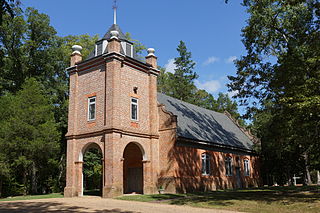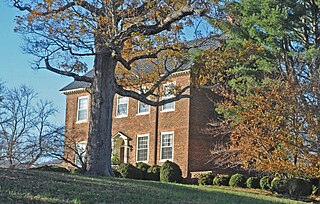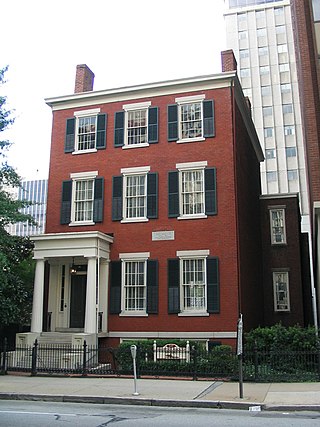
Mount Jackson is a town in Shenandoah County, Virginia, United States. The population was 1,994 at the 2010 census.

St. Peter's Church is a historic Episcopal church near Talleysville, Virginia, United States. Built in 1703, the church was designated as "The First Church of the First First-Lady" by the Virginia General Assembly in 1960 and added to the National Register of Historic Places in 1969. It was designated a National Historic Landmark on March 2, 2012, as an exceptionally well-preserved colonial-era church.

Temple Hall is an early 19th-century Federal-style mansion and working farm near the Potomac River north of Leesburg in Loudoun County, Virginia.

Sycamore Dale is a 19th-century Greek Revival plantation house overlooking the South Branch Potomac River southwest of Romney, West Virginia. Sycamore Dale is one of several historic estates along South Branch River Road. It was listed on the National Register of Historic Places on December 2, 1980.

Frascati is an early 19th-century Federal-style plantation house near Somerset in Orange County, Virginia. Frascati was the residence of Philip P. Barbour, Associate Justice of the Supreme Court of the United States and statesman.

Immanuel Episcopal Church is a historic Episcopal church and cemetery located near Mechanicsville, Hanover County, Virginia.

Bethesda Presbyterian Church is a historic church in Russellville, Tennessee, US, that was used as a hospital during the American Civil War. It is listed on the National Register of Historic Places.

Bloomsbury Farm was an 18th-century timbered framed house, one of the oldest privately owned residences in Spotsylvania County, Virginia. The house was originally built by the Robinson family sometime between 1785 and 1790. It was architecturally significant for its eighteenth-century construction methods and decorative elements. The surrounding location is also significant as the site of the last engagement between Confederate and Union forces in the Battle of Spotsylvania Courthouse on May 19, 1864. Bloomsbury Farm was added to the National Register of Historic Places in May 2000. The house was demolished in December 2014 by Leonard Atkins, a nearby resident who purchased the property in November 2014 ostensibly to restore it. Atkins cited the building's supposedly poor condition and public safety as the reasons for the abrupt demolition, and he planned to replace the historic house with a new one commensurate in style and value with the modern houses in the surrounding development in which he lives. The farm was removed from the National Register in 2017.

Fancy Farm is a historic plantation house located at Kelso Mill, near Bedford, Bedford County, Virginia. It was built about 1785, and is a two-story, five bay brick dwelling in the Late Georgian style. It has a metal gable roof and two interior end chimneys. The interior features original woodwork. The house was restored in 1969–1971. Also on the property are a contributing brick storehouse, a frame kitchen with a stone chimney, and a frame quarters also with a stone chimney. The property features a panorama of the Peaks of Otter. Fancy Farm was used as the headquarters of Union General David Hunter in his Lynchburg campaign during the Valley Campaigns of 1864.

Montrose is a historic farmhouse located near McKenney, Dinwiddie County, Virginia. The original section was built about 1828, and is a 1+1⁄2-story, three-bay, frame structure with a center-hall plan. It has been enlarged at least twice to become L-shaped in plan. It features a double-shouldered end chimneys of stone with brick stacks. The interior has Federal style woodwork. It was the birthplace of the Confederate General Roger Atkinson Pryor and long the home of the locally prominent Baskerville family.

Waverly is a historic home and farm located near Burnt Chimney, Franklin County, Virginia. It was built beginning about 1853 for Armistead Lewis Burwell (1809-1883) and his family, who inherited it from the parents of his wife, Mary Hix (1811-1895). Descended from the First Families of Virginia, Armistead L. Burwell operated a tobacco and grain plantation of about 350 improved acres using enslaved labor, and also had a chewing tobacco factory, gristmill and sawmill by 1860. His son William A. Burwell (1836-1882) ran the factory and bought the plantation from his father in 1864, and sold it in 1868 to his younger brother John Spotswood Burwell who operated a dairy farm until after the turn of the century.

Dickinson–Milbourn House is a historic home located near Jonesville, Lee County, Virginia. It was built between 1844 and 1848, and is a two-story, five-bay, gable roofed brick dwelling. It has a central passage plan and a pair of semi-exterior end brick chimneys at each gable end. Also on the property is the contributing large brick smokehouse.

The Judge Henry Wood Jr. House is a historic home located at Clarksville, Mecklenburg County, Virginia. It is a two-story, Queen Anne style brick dwelling built in three sections. The original section was built between about 1820 and 1840, and forms the center section. The north wing was added after 1872, and the south wing, with an octagonal end, in the 1880s. Confederate General William Mahone (1826-1895), owned the property from 1862 to 1868.

Meems Bottom Covered Bridge is a covered bridge in Shenandoah County, Virginia, United States. The bridge, at 204 feet (62 m), is the longest covered bridge in Virginia and one of the last that supports regular traffic. Near the town of Mount Jackson, the Meems Bottom Covered Bridge features a 200-foot single-span wooden Burr arch structure. Built in 1892 by Franklin Hiser Wissler, the wooden bridge over the North Fork of the Shenandoah River provided access to his apple orchards at Strathmore Farms. The bridge was listed on the National Register of Historic Places on June 10, 1975.

John Beaver House, also known as the Thomas Shirley House, is a historic home located near Salem, Page County, Virginia. It was built in 1825–1826, and is a two-story, four-bay, single pile brick dwelling. It has two entryways, a three-course molded brick cornice under the eaves of the gable roof, and exterior end chimneys. A two-story, five-bay kitchen/dining room ell was added in the late-19th century.

Moor Green is a historic home located near Brentsville, Prince William County, Virginia. It dates to the early-19th century, and is a two-story, five-bay, Federal style brick residence, with a one-room, two-story ell. It has a standing seam metal gable roof and a single-pile, central-passage plan.

Brown's Ferry, also known as the Mahone House, is a historic home near Courtland, Southampton County, Virginia. It was built about 1815, and is a large two-story, five-bay, Federal style brick dwelling. It has a one-story kitchen attached to the rear. The main house has a side gable roof and three interior end chimneys. The interior features notable woodwork and painting. Also on the property are a contributing smokehouse, corn crib, and pole barn. It was the birthplace of Confederate General William Mahone (1826–1895).

Ellerslie is an historic home located at Colonial Heights, Virginia. It is a large 2+1⁄2-story, hip-roofed, Italian Villa style dwelling with a two-story rear service wing connected by an arcade. It features a three-story tower with a hipped roof and a full-width front porch.

Stewart–Lee House, also known as the Norman Stewart House, is a historic home located in Richmond, Virginia. It was built in 1844, and is a three-story, three-bay, Greek Revival style brick townhouse. Its low hipped roof is pierced by four interior end chimneys and surrounded by a simple molded cornice with a plain frieze. In 1864, Robert E. Lee's wife and daughter occupied the house after the confiscation of "Arlington." On April 15, 1865, General Lee retired to the home following the surrender at Appomattox. He resided there only until June 1865, due to the "result of constant callers." In 1893, the building was given to the Virginia Historical Society "for the use and occupation of the Virginia Historical Society as a library and assembly rooms"; they occupied it until 1959. The house was conveyed to the Confederate Memorial Literary Society in 1961, and was listed on the National Register of Historic Places in 1972.

The Almshouse, also known as the City Home is a historic almshouse and hospital complex located in Richmond, Virginia.
























